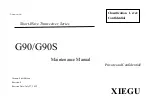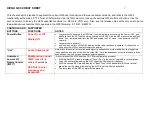
______________________________________________
HARRIS
888-9058-001
WARNING: Disconnect and lockout AC primary power prior to servicing
157
6.4.1.4 Troubleshooting
Verify that the RF detectors have RF present and the DC output voltage is present. If this
is OK, trace the DC back to the switcher logic card and check the comparator output.
Using the schematic as a guide the logic can be traced to the output coax relay driver and
the status driver transistors.
6.4.2 AGC
(Refer to AGC schematic 843-5460-181. Under tab 700)
The AGC or automatic gain control acts as a voltage controlled gain attenuator in a
feedback loop to hold the output power of the transmitter constant. The exciter output
power is the reference, the output power is compared to the reference. Any difference
changes the control voltage of the voltage controlled attenuator. An output amplifier U6
can be used to compensate for some of the loss in the AGC card. Two types of AGC
operation are used.
6.4.2.1 Detailed Circuit Description
•
RF Signal Path
The exciter input is sampled by DC1, attenuated by the selectable fixed pads followed
by a variable hybrid attenuator. The normal configuration is 4 dB in the circuit and the
other sections are bypassed. The attenuator output is followed by a 12 dB fixed
attenuator and 15 dB gain amplifier for a net gain of 3dB. The amplifier may be
bypassed, depending on system gain requirements, by changing JP4, JP5 and JP6. The
output amplifier power limit is 500mW.
•
Voltage Controlled Amplifier
DC1 sample level is 10 dB below the input and is rectified by diode CR5. The
transmitter sample is rectified in a similar manner as the exciter. The two samples are
buffered by sections of U2. The two samples are compared by another section of U2
buffered by another section of U2 and control the current flow through the attenuator
diodes using Q1. This attenuator has a range of 20dB; the change in attenuation controls
the PA drive to each cabinet. Adjustment of TX ADJ, to reduce PA power output, sets
the amount of available attenuation decrease that is available for drive increase. Switch
S1 changes from active AGC to a fixed minimum value of attenuation. The LED, DS1, is
illuminated when the AGC is active. The AGC voltage is buffered by Q2 and available
for metering by the transmitter monitoring system. The active status is also available for
monitoring.
















































